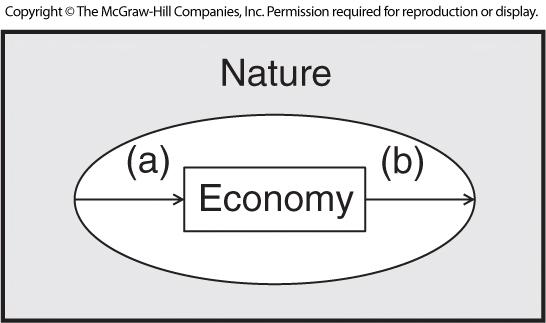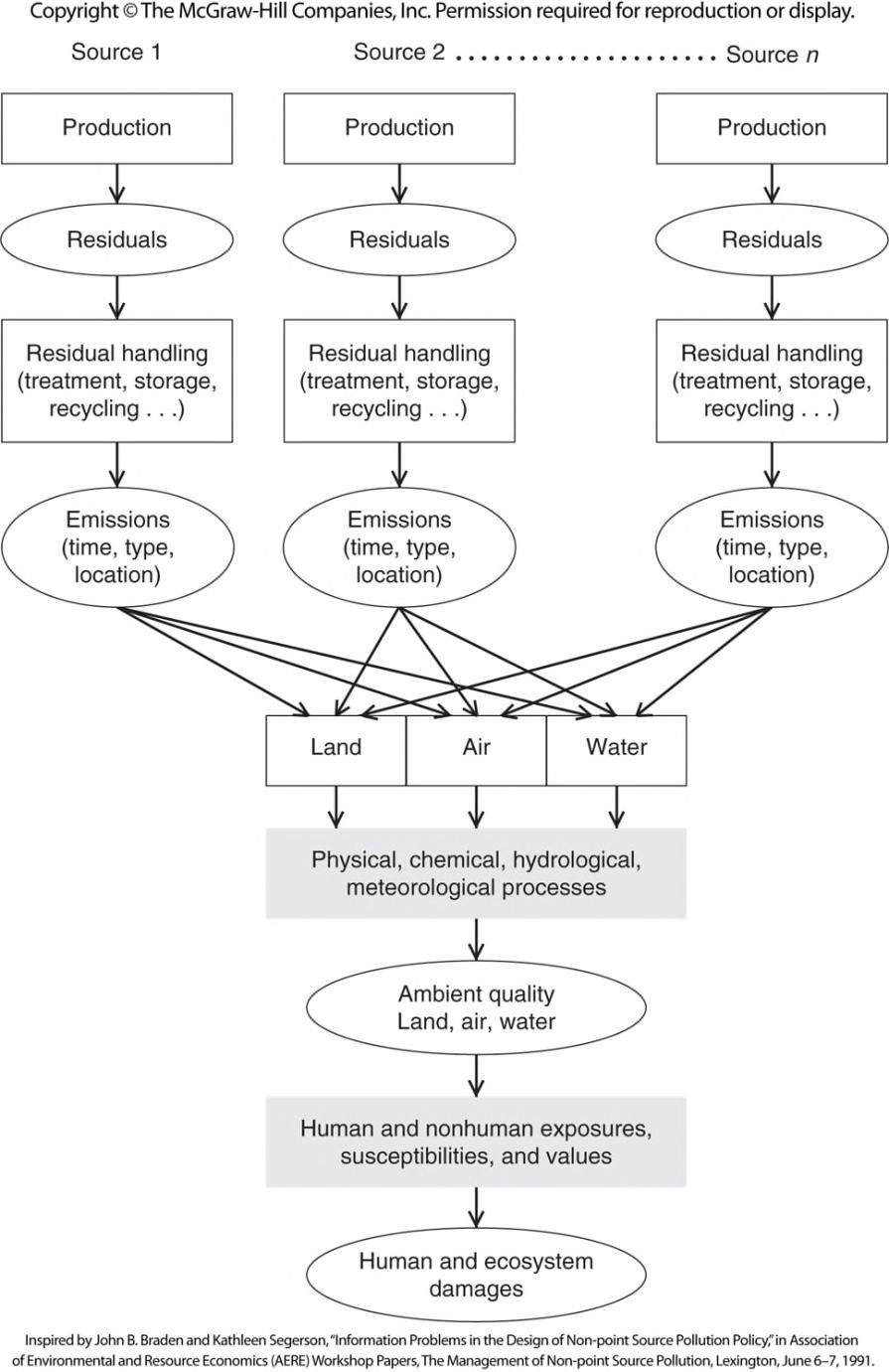THE ECONOMY AND THE ENVIRONMENT
Objectives
This is also an introductory chapter, the primary aim of which is to provide a simple conceptualization of the economy in relation to the natural environment and to establish some definitions and perspectives that will be used throughout the book.
Main Points
A leading idea presented in the chapter is the materials/energy balance relationship; it helps to establish the basic relations between economy and environment, and locates some of the major “pressure points” for developing environmental policy. Since the book is limited to environmental economics, the chapter also contains a very brief discussion of issues in natural resource economics; the close relationship between the two needs to be emphasized.
The materials balance model does not focus on the handling of residuals at the end of production/consumption, so Figure 2.3 is meant to shift emphasis to this part of the problem. It is also useful for bringing up the major problem of control: When two or more sources contribute to a pollution problem, how much should we control each source?
You may wish to postpone the discussion of production possibility curves until later. The ideas of short-run vs. long-run may be presented fairly intuitively without the diagram, and students who have had no economics may be put off at this stage if you take simple ideas and make them technically complex. Whether you present this material at this point will depend on where you wish to place emphasis in the course. The idea of sustainability is presented here, with a simple interpretation in terms of impacts on future production possibilities curves.
Teaching Ideas
This chapter is bound to have a “grab-bag” flavor, because it includes a variety of topics which, in the nature of things, have no underlying theme. There is probably no way around this; some basic terminology and perspective are essential.
Answers to Discussion Questions
1. Investment in new physical capital, infrastructure or otherwise, creates a difference between M and (Rp d + Rc d); as long as long-lived physical capital is accumulating some portion of the material inputs will be incorporated in this capital rather than ending up back in the environment. Ultimately (and this may take a long time) everything that goes in will come out.
2. A pollutant is a residual that causes damage. Thus, a residual that is emitted into the environment but causes no damage is not a pollutant. An airborne pollutant, if it were emitted downwind from anything that could potentially be damaged, would not be a pollutant. The same principle applies to noise and junked automobiles. It would be difficult for an ugly building not to lead to damage, as this would imply that nobody views it; of course, when aesthetics are involved the issue of damage is much more problematic than when classic damaging emissions are involved.
3. A short-lived, noncumulative pollutant does its damage and then disappears, so if we want to reduce damages we need only reduce current emission levels. But a cumulative pollutant stays around to cause damages in the future, so foresight is needed to manage damages, and that is usually difficult to get. It’s hard because the science becomes more difficult—having to predict effects that are a long time in the future, and it’s hard because people ordinarily discount the future.
4. The problem is how to divide the total emission reduction among the sources. This can be done in any number of ways, and different pollution-control policies do it in different ways (equiproportionate cutbacks vs. cost-effective cutbacks, for example). In later chapters this is a very substantial issue.
5. Materials used to produce a single-use plastic bag (M) enter the system and flows to G with excess heat, energy and plastic remnants from the production process flowing to Rp, then to discharge. G (single-use plastic bag) flows to the consumer and then to residual (Rc) and immediately to discharge (Rc d) by the definition of single-use. Some consumers reuse a single-use plastic bag in which case the bag circles among consumers but the form does not change and the entire product is discharged eventually. For a paper shopping bag, materials used to produce it enter the system (M); however, any recycled paper used for a portion of the bag would enter from another processor already in the system. Some of the remnants from the production process flow to Rp, then to discharge. G (paper bag) flows to the consumer and then to residual (Rc). Here the consumer has a choice, and here is where incentive structures can influence greatly the path of the residual. Either the paper bag could be discharged immediately (Rc d) like the single-use plastic bag, or the paper bag could be placed in recycling (Rc r) to circulate back to producers and into the production process, possibly to be part of future paper bags. Without an incentive
to recycle, the paper bag will add to landfill quantities just as the disposal of plastic bags; however, the former will compost and disintegrate at a much faster rate than the latter.
6. A very brief and, at this point, intuitive foray into the idea of social efficiency. The optimal level of expenditures depends on preferences, the costs of control technology, and assimilative capacity of the environment of the political entity in question. In an honors section we sometimes ask students to give us two pages on this type of question during the first week of classes. Near the end of the semester we ask them again to give us two pages on this or a closely related question. Most students are astounded at how far their thinking has evolved during the term.
7. With technological change that allows firms to produce goods and services with less pollution, the slope of the PPC would increase so that at every level of e (environmental quality), the corresponding level of c (market goods) will be higher. Conversely, at every level of c (market goods), the corresponding level of e (environmental quality) will be lower.

Chapter 2
The Economy and the Environment




